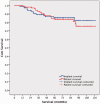Mid-term results of Copeland shoulder cementless surface replacement arthroplasty from an independent centre
- PMID: 27582918
- PMCID: PMC4935077
- DOI: 10.1177/1758573213517227
Mid-term results of Copeland shoulder cementless surface replacement arthroplasty from an independent centre
Abstract
Background: The present study reports our experience of Copeland shoulder cementless surface replacement arthroplasty (CSRA) and whether glenoid microfracture influences the progression of glenoid erosion.
Methods: One-hundred-and-twelve CSRAs were performed in 101 patients between 2002 and 2007. Eighty-three patients were alive at the median follow-up time of 72 months (range 9 to 121 months; interquartile range 46 to 93 months). Assessment included an Oxford shoulder score (OSS), patient satisfaction score and plain radiographs.
Results: The mean (range) OSS was 27 (7 to 48) and 64 of 73 (87.7%) patients were 'very satisfied' or 'satisfied' with their shoulder. Twenty-three (20.5%) shoulders had over 2 mm of glenoid erosion. Microfracture was performed in 43 of 112 shoulders (38.4%) and did not influence the progression of glenoid erosion. Further surgery was performed in 27 (24.1%) shoulders, including 15 revisions, eight arthrolyses and four subacromial decompressions. Revision to total shoulder arthroplasty was performed in 14 : 10 for glenoid erosion; one each for loosening, periprosthetic fracture, deep infection, and chronic pain. One was revised to reverse arthroplasty for chronic pain.
Conclusions: CSRA performed in an independent centre reproduces the functional outcomes reported by the designer. Glenoid erosion, however, was a common occurrence and the main cause of revision - microfracture did not influence its progression.
Keywords: Copeland cementless shoulder resurfacing arthroplasty; glenoid erosion; glenoid microfracture; independent centre.
Figures
References
-
- Levy O, Copeland SA. Cementless surface replacement arthroplasty of the shoulder. 5- to 10-year results with the Copeland mark-2 prosthesis. J Bone Joint Surg Br 2001; 83: 213–21. - PubMed
-
- Burgess DL, McGrath MS, Bonutti PM, Marker DR, Delanois RE, Mont MA. Shoulder resurfacing. J Bone Joint Surg Am 2009; 91: 1228–38. - PubMed
-
- Copeland S. The continuing development of shoulder replacement: ‘reaching the surface’. J Bone Joint Surg Am 2006; 88: 900–5. - PubMed
-
- Gill DR, Cofield RH, Morrey BF. Ipsilateral total shoulder and elbow arthroplasties in patients who have rheumatoid arthritis. J Bone Joint Surg Am 1999; 81: 1128–37. - PubMed
-
- Levy O, Funk L, Sforza G, Copeland SA. Copeland surface replacement arthroplasty of the shoulder in rheumatoid arthritis. J Bone Joint Surg Am 2004; 86: 512–8. - PubMed
LinkOut - more resources
Full Text Sources
Other Literature Sources


